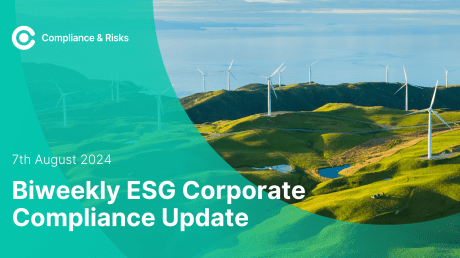
Ask Our Experts: Top Frequently Asked Questions on Sustainable Resource Use

This blog was originally posted on 13th August, 2024. Further regulatory developments may have occurred after publication. To keep up-to-date with the latest compliance news, sign up to our newsletter.
At Compliance & Risks, we help the world’s leading brands to monitor and manage global regulations and standards via C2P, our comprehensive SaaS platform. We enable you to monitor, assess and prove your products’ compliance, protecting your brands and helping drive growth.
In our new ‘Ask our Experts’ series, we bring you some of the pressing questions asked by your peers on a hot compliance topic. This month, we break down some of the top frequently asked questions on Sustainable Resource Use.
EU: Framework for Ensuring a Secure and Sustainable Supply of Critical Raw Materials, Regulation (EU) 2024/1252
Question 1:
Are the requirements and limitations on raw materials sourced for products manufactured in the EU, sold in the EU or both?
To be honest, it depends on the requirement in question. Two of the main requirements for companies are as follows:
1. Risk Assessment
For large companies there is a risk assessment obligation in Article 24 to be carried out on their raw materials supply chain.
Art. 24 applies to large companies which are defined as “a company with more than 500 employees on average and a net worldwide turnover of more than EUR 150 million in the most recent financial year for which annual financial statements have been prepared”.
These companies must be identified by an EU Member State in order to fall under the requirement of Article 24 as a company that is operating on their territory and uses strategic raw materials to manufacture equipment of the the type of products mentioned in Art. 24 (1) (.ie batteries for energy storage and e-mobility, heat pumps, equipment related to data transmission and storage, mobile electronic devices, etc.)
The strategic raw materials are those which are listed in Annex I and include material such as copper, cobalt, lithium, etc.
We can see that “Raw materials supply chain’ is defined as meaning” all activities and processes of the raw materials value chain up to the point where a raw material is used as an input for the manufacturing of intermediate or final products”.
Based on the above, I would think this obligation applies to companies manufacturing products in the Member States.
2. Permanent Magnets
Whereas Article 28 and 29 apply to any company placing certain products on the market that contain one or more permanent magnets (.ie neodymium-iron-boron; samarium-cobalt; aluminum-nickel-cobalt; or ferrite.).
Article 28 contains specific labeling requirements and Article 29 contains requirements relating to information on websites after which this will lead to the EU Commission adopting a delegated act containing measures to enforce minimum content shares.
The type of products this applies to are listed in Art. 28(1) as magnetic resonance imaging devices, wind energy generators, industrial robots, motor vehicles, light means of transport, cooling generators, heat pumps, electric motors, including where electric motors are integrated in other products, automatic washing machines, tumble driers, microwaves, vacuum cleaners or dishwashers.
In this case, Article 28 and 29 apply to products placed on the market (so both manufactured in the EU and imported from outside the EU to be placed on the market). Furthermore, ‘placing on the market’ is defined as the first making available of a product on the Union market.
Question 2:
Art. 24 talks about the company risk preparedness and it mentions “equipment related to data transmission and storage”. There is not a more specific list of products that may be included in that list, do you know about more examples?
No, there is not a more specific list of products for Article 24. The criteria for the requirement to apply depends on company size/turnover, use of strategic raw materials and identification by a Member State.
The requirement in Art. 24 applies to large companies which are defined in the text as “a company with more than 500 employees on average and a net worldwide turnover of more than EUR 150 million in the most recent financial year for which annual financial statements have been prepared”.
These companies must be identified by an EU Member State in order to fall under the requirement of Article 24 as a company that is operating on their territory and uses strategic raw materials to manufacture equipment related to data transmission and storage.
The strategic raw materials are those which are listed in Annex I as follows:
- Bauxite/alumina/aluminum;
- Bismuth;
- Boron — metallurgy grade;
- Cobalt;
- Copper;
- Gallium;
- Germanium;
- Lithium — battery grade;
- Magnesium metal;
- Manganese — battery grade;
- Graphite — battery grade;
- Nickel — battery grade;
- Platinum group metals;
- Rare earth elements for permanent magnets (Nd, Pr, Tb, Dy, Gd, Sm, and Ce);
- Silicon metal;
- Titanium metal;
- Tungsten.
Question 3:
As stated in article 24, companies identified by the respective member states should carry out a risk assessment of their supply chain with regard to the security of supply of strategic raw materials. This risk assessment refers to the processing steps:
Unfortunately, here is no additional information on the level of detail required to comply with the risk assessment obligation in Article 24.
Art. 24 applies to large companies which are defined as “a company with more than 500 employees on average and a net worldwide turnover of more than EUR 150 million in the most recent financial year for which annual financial statements have been prepared”.
These companies must be identified by an EU Member State in order to fall under the requirement of Article 24 as a company that is operating on their territory and uses strategic raw materials to manufacture equipment of the type of products mentioned in Art. 24 (1).
As per Art. 24(2) the risk assessment will include:
(a) A mapping of where the strategic raw materials they use are extracted, processed or recycled;
(b) An analysis of the factors that might affect their supply of strategic raw materials;
(c) An assessment of their vulnerabilities to supply disruptions.
The strategic raw materials are those which are listed in Annex I and include material such as copper, cobalt, lithium, etc. There is no minimum threshold mentioned for the risk assessment requirement to apply.
“Raw materials supply chain’ is defined as meaning” all activities and processes of the raw materials value chain up to the point where a raw material is used as an input for the manufacturing of intermediate or final products”.
As it is up to each Member State to identity the relevant companies involved, we would expect as part of this identification the Member State to explain the level of detail required to comply with this requirement.
Your Questions Answered
The above questions on Sustainable Resource Use were submitted and answered via the “Ask Our Experts” (AOE) button in C2P.
Our customers use AOE to ask about the latest proposed, enacted and amended regulations and mandatory standards applicable to their products and geographies of interest.
When AOE questions can be answered in 30 minutes or less, Compliance & Risks’ subject matter experts answer them at no charge!
To learn more about C2P and how Compliance & Risks’ SMEs can help you with your questions, start a conversation today.
Meet our Experts

Global Regulatory Compliance Team
Our team of experts will elevate your strategic edge by addressing questions about laws and regulations. Fluent in almost 30 languages and backed by an extensive database of 90,000+ sources, our experts bring unparalleled knowledge to the table. Moreover, our expert team is dedicated to educating your organization, fostering better engagement, and ensuring your compliance and risk management strategies are second to none. With our team of seasoned professionals by your side, you’ll gain a competitive edge in navigating the complex landscape of compliance management, gaining deeper insights and valuable guidance


